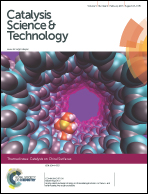Mesoporous carbon with controllable pore sizes as a support of the AuCl3 catalyst for acetylene hydrochlorination
Abstract
Mesoporous carbon materials with controllable pore sizes within the range of 5.6–40.5 nm were successfully synthesized using colloidal silica as hard templates and boric acid as the pore expanding agent. The catalytic properties of the 0.5% AuCl3 loaded mesoporous carbon catalysts towards acetylene hydrochlorination were tested in a fixed-bed reactor. Under reaction conditions of 180 °C, C2H2 hourly space velocity = 720 h−1 and HCl/C2H2 feed volume ratio = 1.15, it was found that larger mesoporous carbon supports could accelerate the reaction rate, resulting in higher acetylene conversion. The AuCl3 catalyst supported on mesoporous carbon with a pore size of about 40.5 nm displayed excellent catalytic activity (acetylene conversion was above 83%). The dependence of regular catalytic performance on pore size is important for acetylene hydrochlorination because large pore sizes enable fast molecular diffusion, thus suppressing coke formation.


 Please wait while we load your content...
Please wait while we load your content...